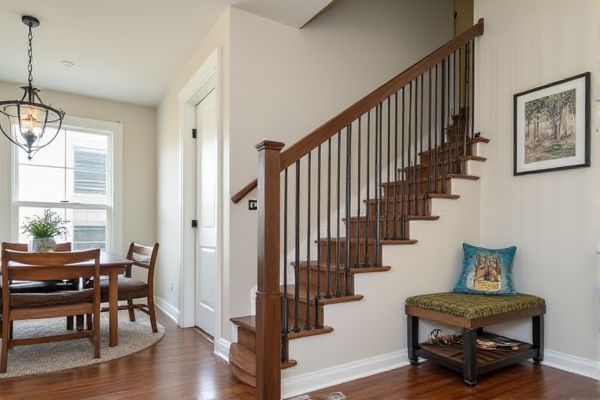
Wall-mounted railing offers a sleek, space-saving design ideal for narrow areas, while post-mounted railing provides versatility and greater structural support, often preferred for open spaces. Explore the key differences and benefits of each option to determine which railing best suits Your needs throughout the rest of this article.
Table of Comparison
| Feature | Wall-Mounted Railing | Post-Mounted Railing |
|---|---|---|
| Installation | Fixed directly to walls | Installed onto floor or ground via posts |
| Design Flexibility | Limited to wall locations | Flexible placement and layout |
| Space Efficiency | Requires minimal floor space | Needs floor clearance for posts |
| Structural Support | Relies on wall strength | Self-supporting with posts |
| Maintenance | Typically easier with less exposure | May need more upkeep due to exposure |
| Applications | Indoor corridors, staircases | Balconies, decks, open areas |
| Cost | Generally lower due to simpler installation | Higher material and labor costs |
Introduction to Wall-Mounted and Post-Mounted Railings
Wall-mounted railings attach directly to the surface of a wall, offering a sleek, space-saving solution ideal for narrow staircases and hallways. Post-mounted railings are supported by vertical posts anchored to the floor or stairs, providing robust stability and greater design flexibility for outdoor decks and large staircases. Choosing the right option depends on Your space constraints, aesthetic preferences, and functional needs.
Key Differences Between Wall-Mounted and Post-Mounted Railings
Wall-mounted railings attach directly to existing walls, providing a sleek and space-saving solution ideal for narrow staircases or corridors, while post-mounted railings require installation with vertical posts anchored into the floor or ground, offering greater flexibility in design and placement. Wall-mounted railings typically offer a minimalist aesthetic and are easier to clean, whereas post-mounted options provide enhanced support and stability for open areas such as decks or balconies. Understanding these key differences helps you choose the best railing type to suit your architectural needs and safety requirements.
Advantages of Wall-Mounted Railings
Wall-mounted railings offer space-saving benefits by attaching directly to existing walls, making them ideal for narrow or confined areas where floor space is limited. Their installation typically involves fewer components, which can reduce costs and enhance structural stability compared to post-mounted railings that require support posts anchored into the floor or ground. You can also enjoy a cleaner, more streamlined aesthetic with wall-mounted railings, as they do not obstruct walkways or views, providing both safety and an unobtrusive design element.
Benefits of Post-Mounted Railings
Post-mounted railings provide superior stability and durability by being anchored directly into the ground or deck surface, allowing them to withstand higher loads and harsh weather conditions. They offer greater flexibility in design and installation, accommodating various deck heights and architectural styles with ease. Maintenance is often simpler since post-mounted systems allow for easier access to individual components for repairs or replacement.
Installation Requirements and Processes
Wall-mounted railing requires direct attachment to the wall using secure anchors, making it ideal for spaces with solid, load-bearing surfaces and needing minimal floor space. Post-mounted railing involves setting posts into the floor or ground, often requiring concrete footings or mounting brackets for stability, which suits open areas or staircases without adjacent walls. Your choice depends on available structural support and desired installation complexity, impacting overall safety and aesthetic integration.
Safety and Compliance Considerations
Wall-mounted railings offer enhanced stability as they are securely anchored to a building's structure, meeting stringent safety codes in high-traffic indoor and outdoor spaces. Post-mounted railings provide flexibility in design and placement but require careful installation to comply with local building regulations and ensure proper load-bearing capacity. Your choice should prioritize compliance with ANSI and OSHA standards to guarantee optimal safety and structural integrity.
Design Aesthetics and Customization Options
Wall-mounted railings offer a sleek, minimalist look by attaching directly to the wall, enhancing modern and space-saving designs, while post-mounted railings provide a more traditional and versatile appearance with freestanding supports that can be customized in height, material, and style. You can choose from various materials like metal, wood, or glass for both types, but post-mounted options allow greater flexibility in creating intricate patterns or adding decorative posts. Design aesthetics in wall-mounted railings emphasize clean lines and unobtrusiveness, whereas post-mounted railings serve as prominent design features that can be tailored to your specific architectural preferences.
Durability and Maintenance Needs
Wall-mounted railings typically offer enhanced durability by being securely fastened directly to the wall, reducing exposure to stress from external elements compared to post-mounted railings, which are more vulnerable to ground moisture and shifting. Maintenance needs for wall-mounted railings are generally lower, as they avoid direct contact with soil that can cause corrosion or rot, while post-mounted railings often require more frequent inspections and treatments to prevent wear and structural weakening. Choosing the right railing system can extend the lifespan of your installation, minimizing repair costs and upkeep over time.
Cost Comparison: Wall-Mounted vs Post-Mounted Railings
Wall-mounted railings typically cost less than post-mounted railings due to reduced material requirements and simpler installation processes; you save on the expense of additional posts and extended labor. Post-mounted railings often involve higher costs because they require sturdy posts anchored into the ground or structure, adding to both material and labor expenses. Choosing between the two depends on your budget, structural support, and aesthetic preferences.
Choosing the Right Railing Type for Your Project
When choosing the right railing type for your project, consider that wall-mounted railings offer a sleek, space-saving design ideal for narrow staircases or landings, providing stability by attaching directly to existing walls. Post-mounted railings, on the other hand, are versatile and sturdy, suitable for open areas where you need to define boundaries or support without relying on wall structures. Your decision should factor in the architectural layout, safety requirements, and aesthetic preferences to ensure optimal functionality and visual appeal.
 homyna.com
homyna.com